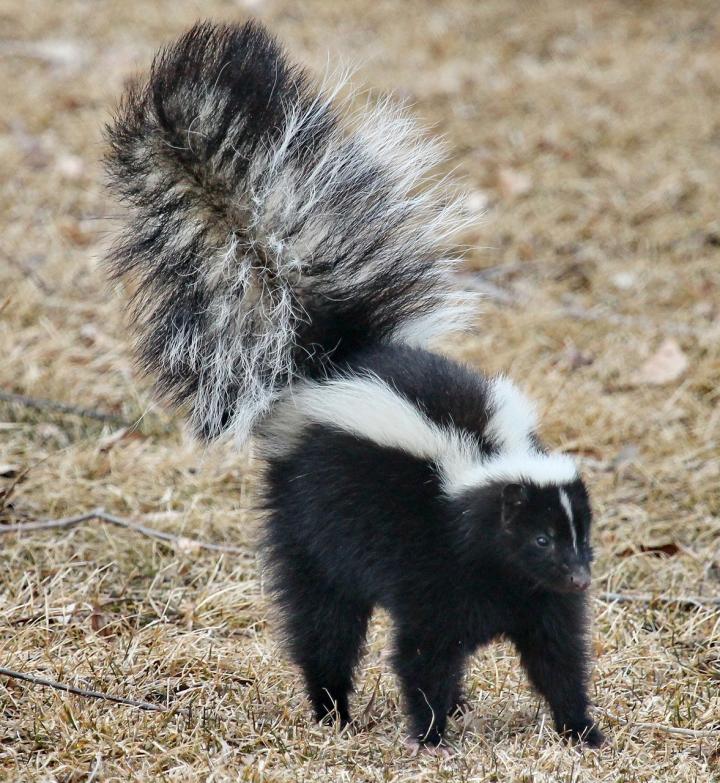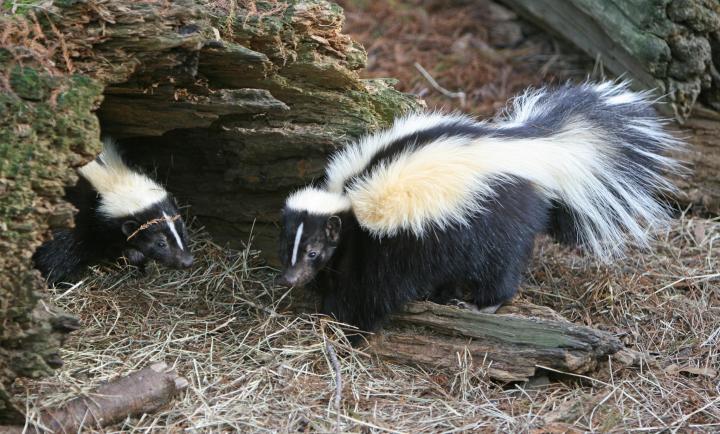
Skunks are docile animals but may spray if threatened.
Also, Learn Why and How Skunks Spray!
ADVERTISEMENT
My 5 year old male tabby and the skunk must have literally came around the corner of my house at the exact same time. He must have only been inches away because he couldn’t open his eyes. They were watering badly, he was drooling, foaming from the mouth and the oil slick on his head was so thick. It’s the most pungent thing I’ve ever smelled in my entire life. We think it’s the nastiest smell ever just driving down the street. We took him to the vet hospital, they checked his eyes gave us drops and a shampoo.
My 5 year old male tabby and the skunk must have literally came around the corner of my house at the exact same time. He must have been only inches away, he couldn’t open his eyes, was drooling, slightly foaming
Try spraying the skin, clothes and fur with Unscented Febreze and see what you think. It must be the unscented version of brand name Febreze. This product has done wonders.
Had a family of skunks take shelter from the winter under my house (no basement). They were so noisy that they would make the dogs bark. That, in turn, made the skunks defensive and odoriferous. Many a 4am I’d have to open windows and doors. I guess we were too noisy for them, they moved on in early spring. Skunks have several nests. This one got sealed off after they left.
Contrary to the article skunks loved my cabbage last year destroying 30 heads. This year they are inside a chicken wire fence.
From your article:
Under a skunk’s tail are two pouches equipped with a pair of ducts that remain hidden in peacetime but quickly expose themselves when danger threatens. Their foul ammunition is a golden-yellow liquid whose active ingredient is the sulfide mercaptan. Each of the two pouches contains enough ammunition for six rounds. After the supply is exhausted, a week is required to replenish it. This spray means skunk creatures are feared by nearly all animals, including most of mankind.
This statement is incorrect "skunk creatures are feared by nearly all animals", my dog lives to chase them!!! Unfortunately he is a house dog who gets a lot of baths!!
When living in Alton NH I had a long 300 foot driveway. One pitch black night I walked the driveway. I sensed something was sharing the driveway with me. Got about 3 feet from a striped animal, there wasn’t any smell but knew what it was. Retreated rather quickly and apparently it didn’t feel threatened, so we both went on our merry ways.
When stationed in the Air Force in OK & TX a few years the natives called them Polecats. But a Polecat is like a weasel, but that was called a skunk. The animals stunk like skunks and looked like them. Geographical naming.
Recently, a TV infomercial promoting an aerosol spray that eliminates many odors (some quite bad) quickly. Might be something to try for Skunk on yourself or animals. Do a search.
Noted some commenters said to use Tomato Juice and some commenters said it didn’t work. I side with those that said it doesn’t work. A better use for Tomato Juice (or Clamato Juice) is to mix it with Vodka on ice and read about Skunks on the OFA articles.
You can tell when spring is here. Many roads are known as Flat Skunk highway. Stinks as you drive along.
Bake Cinnamon Sticks for a couple hours at 250 degrees.
I can't for the life of me figure why skunks are an issue at all. I have a huge garden and there are lots of little holes, but they have never damaged any of my plants. As for the lawn, the grass is, as far as I'm concerned, a shameful thing to care about. It costs money and resources to keep perfect, and cutting it is usually with a gas mower, blower, and edger--hideously pollutant, but also creates a miniature Armageddon for all the creatures chopped up by the blades, not to mention noisy as hell. You use valuable water on a plant that provides no sustenance, and most people don't even spend much time in their yards. And then you begrudge skunks and other animals the right to dig for food in order to protect that wasteful patch of green.
I share my yard with the wildlife, and the skunks and I just mozy about the yard in the evening, doing our own thing. The raccoons are harder to adjust to, but with gentle tactics, we've figured it out. They don't pay me much mind. If you have a dog, keep in mind that the wildlife has more natural right to hang out than your dog does. And as we keep having children and development seems endless, our yards are the only places they can live in. Plant natives that provide food. Leave out fresh water. Keep your yard wild with places to burrow. Protect them or they will be gone.
TOTALLLY agree with you, Tricia. I'm of like mind. They're no problem at all, and if we all just lived and let live, everyone would be better off.











